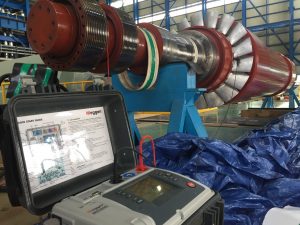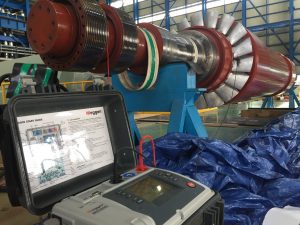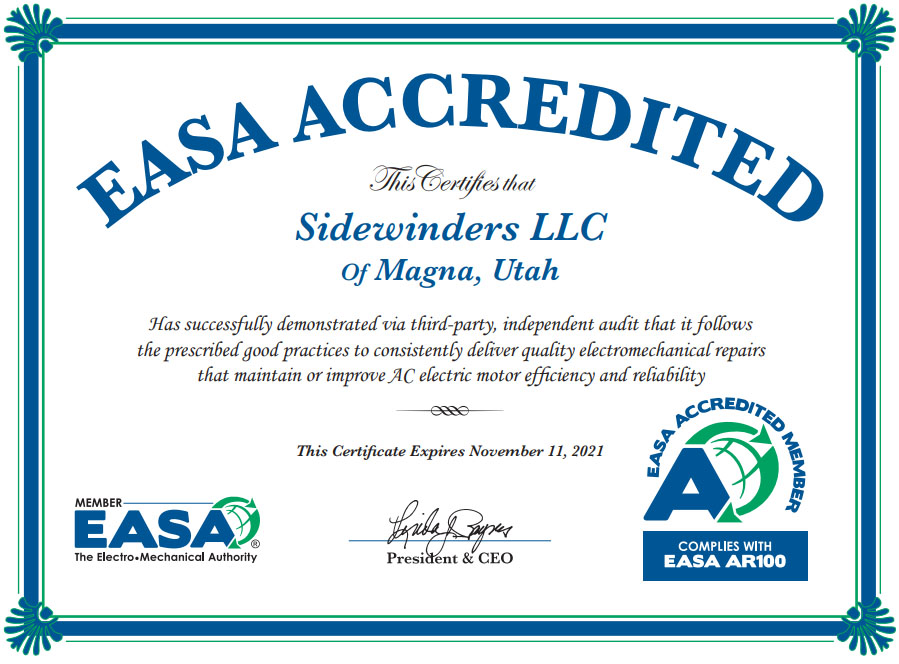
GENERATOR ROTOR TESTING
Before we talk about generator rotor testing, let’s make sure we are all on the same page in terms of understanding what a rotor does. First, let’s start with a quick discussion of terminology. Some OEMs such as GE refer to the rotating portion of the generator as the field. Others, such as Siemens refer to it as the rotor. Both are correct, but both have their limitations. “Rotor” is convenient because it tells us that it is a rotating component. “Field” tells us that it is a DC electromagnet with multiples of two poles. “Rotor” and “Field” get confusing when we talk about a brushless exciter where the field (the DC part) is stationary and the armature (the AC part) is the rotor. The correct term from an electrical engineering standpoint is “field”, whereas the term “armature” always refers to the alternating current component whether it is stationary or rotating. The rotor transmits its torque to the stator by means of locking or synchronizing its magnetic field rotation to that of the stator. The strength of this magnetic locking is proportional to how much current we force to flow through the rotor. We can also influence the voltage of the grid, if the grid is small compared to the capacity of the generator, OR, in cases where the generator is connected to an infinite grid we can not raise the grid voltage appreciably but we can help the grid by exporting VARs. The subject of VARs is a subject matter deserving its own separate discussion—for another time.
On a 60 Hertz unit, the rotor’s magnetic field makes 60 rotations per second, and the stator’s magnetic field also rotates 60 times per second. If the generator breaker is open, and excitation is on, the generator will produce full rated voltage, and zero current.
With the breaker open, or if the unit is on a small island grid where it is the main or only generator (isochronous mode), raising excitation will result in an immediate raise in grid voltage.
Unlike the stator, where virtually all of the windings are buried under many layers of mica and epoxy insulation, the rotor windings are open to the environment, and have minimal insulation. For this reason, rotors are particularly vulnerable to ground faults and inter-turn shorts (“shorted turns”).
As with all generator testing, the objectives are fairly clear:
- Verify that all insulators insulate properly, and;
- Verify that all conductors conduct properly
Not much more to it than that! We are talking about copper, steel, and insulation, after all.
There are a multitude of tests that the OEMs call for on rotors during troubleshooting or re-winding, but the most common maintenance tests are as follows:
- Insulation resistance and polarization test (“Megger & P.I.”)
- DC resistance test
- AC impedance test
- RSO test
Sidewinders follows IEEE 56 – §8.2 and OEM guidance in performing and evaluating these tests.
The following provides a summary of each of the above-listed tests and how Sidewinders evaluates the data.
Insulation resistance and polarization test
 Most commonly referred to as “megger & PI”, this test is a very short, simple, and safe test which gives us a lot of information about the insulation system in a relatively short amount of time. The “megger” part of the test consists of applying a steady DC voltage to the winding under test. For most stators 13,800 and over, most OEMs call for 5,000 to be held for 10 minutes. For rotor windings, 500 VDC is the standard voltage.
Most commonly referred to as “megger & PI”, this test is a very short, simple, and safe test which gives us a lot of information about the insulation system in a relatively short amount of time. The “megger” part of the test consists of applying a steady DC voltage to the winding under test. For most stators 13,800 and over, most OEMs call for 5,000 to be held for 10 minutes. For rotor windings, 500 VDC is the standard voltage.
When explaining electrical concepts, it is helpful to make an analogy to a water piping system that everyone understands. A common garden hose with zero pressure, and the valve closed at the other end will swell up when the water is first turned on, and you can hear and feel the water rushing into the hose, even though nothing is coming out of the other end due to the valve being shut. Comparing voltage to pressure, an electrical winding has a similar charging-up current when we first apply the megger voltage. Even though the system is an open circuit, somehow there is still current flowing in! The is because the insulation molecules are re-orienting themselves so that the dipole aligns with the electric field that is stressing the insulation. As the insulation electrically “stretches” just as the garden hose swells up a bit, the back pressure in the hose pushes back to resist the flow of additional water from coming in as the pressure equalizes with the source (faucet / megger) pressure (60 PSI / 5,000 VDC). This will cause the resistance readings on the test set to rise, giving higher resistance values with time. By the end of the 10 minute “soak” period, the winding charging current will have essentially bled off to zero, and any leakage current that remains will be assumed to be due to imperfections in the winding insulation.
The polarization index (PI) is computed as a ratio of the 10 minute resistance divided by 1-minute resistance. On stators you want to see at least a 100% improvement over a ten-minute period, or a PI=2.0 or higher. On rotors, owing to the open insulation system, a lower PI is expected, while we like to see 2.0 or higher, it is much more common to see PI’s in the 1.2 – 1.5 range. These readings are acceptable as long as the actual meg-Ohm value is sufficiently high. Sidewinders has additional OEM-specific criteria for interpreting low PI values.
DC resistance test
 This test is very straightforward. Using a digital low resistance ohmmeter (DLRO), we apply a 10-amp current through the rotor winding circuit and measure the voltage drop. The instrument takes this data, and by using Ohm’s law, calculates the resistance. Due to the thermal properties of copper, the resistance varies greatly with temperature, so it is not enough to just record the resistance value—we must also record the temperature of the winding. Today, you may be testing a unit outdoors at 75 degrees F and get a certain test value, and the next person may test the unit in the middle of January and get a much lower value. Sidewinders always converts the actual resistance to what it would have been if it were taken at
This test is very straightforward. Using a digital low resistance ohmmeter (DLRO), we apply a 10-amp current through the rotor winding circuit and measure the voltage drop. The instrument takes this data, and by using Ohm’s law, calculates the resistance. Due to the thermal properties of copper, the resistance varies greatly with temperature, so it is not enough to just record the resistance value—we must also record the temperature of the winding. Today, you may be testing a unit outdoors at 75 degrees F and get a certain test value, and the next person may test the unit in the middle of January and get a much lower value. Sidewinders always converts the actual resistance to what it would have been if it were taken at
25 C. This standardization allows an “apples-to-apples” comparison between all test data.
This test is important as it allows us to see if there is any change in resistance with time, since the previous test, or since the manufacture date. Winding resistance rarely goes down—if things go bad, they usually go up. Resistances go up when braze joints start to fail, or when silver plated surfaces degrade. In cases where resistance goes down, we would suspect shorted turns.
AC impedance test
 The AC impedance test is used to find indications of shorted rotor turns. The test is performed by means of applying an AC voltage across the field winding and raising it in 10-volt steps up to 100-120 volts, or till the current supply gets maxed out. We measure the current at each step. Using Ohm’s law, we calculate the impedance Z=V/I where Z is the magnitude of the complex impedance (Z=R + jwL) the resistive component and the inductive component), V = voltage applied, and I=resultant current.
The AC impedance test is used to find indications of shorted rotor turns. The test is performed by means of applying an AC voltage across the field winding and raising it in 10-volt steps up to 100-120 volts, or till the current supply gets maxed out. We measure the current at each step. Using Ohm’s law, we calculate the impedance Z=V/I where Z is the magnitude of the complex impedance (Z=R + jwL) the resistive component and the inductive component), V = voltage applied, and I=resultant current.
As we raise the voltage, the voltage differences across each turn of the winding also increases. At low voltages, we often don’t see the inter-turn short conducting until the voltage raises to a point where the shirt begins to conduct. At this transition point, we would see a step change in the impedance. We would see a step in the graph.
Another way we analyze the data is to run it up in 10-volt steps, then run it back down in 10-volt steps. Normally, the data will show some hysteresis, which is normal and expected. The important part is that the data start and end at the same point. A closed path is good—a path that starts and ends at two different points is suggestive of shorted turns. Due to hysteresis, it is important that as we raise voltage between steps, we don’t back-track if we overshoot a test value. In other words if we are trying to dial in 20 volts, but we overshoot to 21.05 volts, we don’t go backwards and try to tune in exactly 20 volts. The hysteresis will cause a different current to flow than if we had not back-tracked!
In cases where a shorted turn is suspected, we typically call for an RSO test to confirm it. It is Sidewinder’s philosophy not to condemn a unit to be rewound without performing additional testing to confirm the fault. This is where the RSO test comes in handy!
RSO test
 RSO stands for Recurrent Surge Oscillography. RSO is a low-voltage test which applies a high-frequency (RF) train of pulses into one end of the rotor and detects the energy wave form coming out the other end. It is similar to the RADAR concept in that it uses a time-of-flight concept to detect electrical obstructions such as shorted turns within the winding. The test alternately injects energy in one direction and measures the energy from the other side, then switches directions. This provides two oscilloscope traces. In an ideal rotor winding with no shorted turns, the two waveforms can be superimposed perfectly over each other. If they cannot be perfectly matched up, this is an indication of shorted turns. We use the “math” function on the oscilloscope to subtract channel 1 from channel 2 to give a “difference” trace. If traces on channels 1 & 2 are identical, then CH1 – CH2 will be equal to zero.
RSO stands for Recurrent Surge Oscillography. RSO is a low-voltage test which applies a high-frequency (RF) train of pulses into one end of the rotor and detects the energy wave form coming out the other end. It is similar to the RADAR concept in that it uses a time-of-flight concept to detect electrical obstructions such as shorted turns within the winding. The test alternately injects energy in one direction and measures the energy from the other side, then switches directions. This provides two oscilloscope traces. In an ideal rotor winding with no shorted turns, the two waveforms can be superimposed perfectly over each other. If they cannot be perfectly matched up, this is an indication of shorted turns. We use the “math” function on the oscilloscope to subtract channel 1 from channel 2 to give a “difference” trace. If traces on channels 1 & 2 are identical, then CH1 – CH2 will be equal to zero.
Plotting the difference trace will show a flat line in a perfect unit, and will show a flat line with a “blip” on a unit with shorts.
RSO by itself can confirm shorted turns, but it does not tell us WHERE the short is located. It is just a “go-no-go” test. The only true test for shorted turns which tells us which coil has a short, and how many, is the flux probe. We will discuss the merits of the flux probe in a future edition of this blog.


